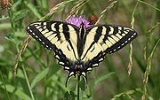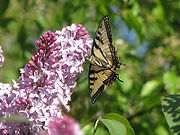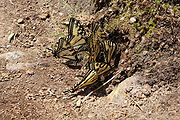
Papilio canadensis
Encyclopedia
The Canadian Tiger Swallowtail (Papilio canadensis) is a species of the Papilionidae family. It was once classified as a subspecies of Papilio glaucus
.
 Adult
Adult
The wingspan of this particular species is 67 to 80 mm long. There are two adult morphs
yellow and black, although the black form is considered quite rare. This species is very similar to the Eastern Tiger Swallowtail
and has a noticeably smaller wingspan. Unlike the Eastern Tiger Swallowtail
the yellow marginal band is continuous. The hindwing has many orange scales, on both morphs. This species has also been known to be hybridized with both the Eastern Tiger Swallowtail
and Western Tiger Swallowtail even if this is extremely rare.
Caterpillar
A large green caterpillar
with an enlarged head. It has 4 yellow dots and 2 false eyes with bluish centers. A profile view of this caterpillar is similar with that of a snake-like figure. The immature larvae are brown and white to mimic bird droppings, this mimicry makes it unappealing to predators.
, as its name implies. Its range extends north of the Arctic Circle in Yukon, and to Churchill in Manitoba, Little Shagamu River in Ontario, and to Schefferville in Quebec. It has not been reported from Labrador but has been seen in western Newfoundland. It is seen in the northern-third of the United States
. Within this range it is a very common and well known butterfly, even more so around woodland edges. It is one of the most popular puddling species and often hundreds will gather at a single puddle.
 Adults fly during spring and summer and there is 1 brood. Females lay eggs singly on the host plant. The caterpillar will fold the host plants leaves and tie them together with silk they will then eat from this structure. The pupae will over winter then emerge in May.
Adults fly during spring and summer and there is 1 brood. Females lay eggs singly on the host plant. The caterpillar will fold the host plants leaves and tie them together with silk they will then eat from this structure. The pupae will over winter then emerge in May.
Adult food
Larval food
Eastern tiger swallowtail
The Eastern Tiger Swallowtail is a species of swallowtail butterfly native to North America. It is one of the most familiar butterflies in the eastern United States, where it is common in many different habitats. It flies from spring to fall, during which it produces two to three broods...
.
Description

The wingspan of this particular species is 67 to 80 mm long. There are two adult morphs
Polymorphism (biology)
Polymorphism in biology occurs when two or more clearly different phenotypes exist in the same population of a species — in other words, the occurrence of more than one form or morph...
yellow and black, although the black form is considered quite rare. This species is very similar to the Eastern Tiger Swallowtail
Eastern tiger swallowtail
The Eastern Tiger Swallowtail is a species of swallowtail butterfly native to North America. It is one of the most familiar butterflies in the eastern United States, where it is common in many different habitats. It flies from spring to fall, during which it produces two to three broods...
and has a noticeably smaller wingspan. Unlike the Eastern Tiger Swallowtail
Eastern tiger swallowtail
The Eastern Tiger Swallowtail is a species of swallowtail butterfly native to North America. It is one of the most familiar butterflies in the eastern United States, where it is common in many different habitats. It flies from spring to fall, during which it produces two to three broods...
the yellow marginal band is continuous. The hindwing has many orange scales, on both morphs. This species has also been known to be hybridized with both the Eastern Tiger Swallowtail
Eastern tiger swallowtail
The Eastern Tiger Swallowtail is a species of swallowtail butterfly native to North America. It is one of the most familiar butterflies in the eastern United States, where it is common in many different habitats. It flies from spring to fall, during which it produces two to three broods...
and Western Tiger Swallowtail even if this is extremely rare.
Caterpillar
A large green caterpillar
Caterpillar
Caterpillars are the larval form of members of the order Lepidoptera . They are mostly herbivorous in food habit, although some species are insectivorous. Caterpillars are voracious feeders and many of them are considered to be pests in agriculture...
with an enlarged head. It has 4 yellow dots and 2 false eyes with bluish centers. A profile view of this caterpillar is similar with that of a snake-like figure. The immature larvae are brown and white to mimic bird droppings, this mimicry makes it unappealing to predators.
Distribution
This butterfly is found in most provinces and territories in CanadaCanada
Canada is a North American country consisting of ten provinces and three territories. Located in the northern part of the continent, it extends from the Atlantic Ocean in the east to the Pacific Ocean in the west, and northward into the Arctic Ocean...
, as its name implies. Its range extends north of the Arctic Circle in Yukon, and to Churchill in Manitoba, Little Shagamu River in Ontario, and to Schefferville in Quebec. It has not been reported from Labrador but has been seen in western Newfoundland. It is seen in the northern-third of the United States
United States
The United States of America is a federal constitutional republic comprising fifty states and a federal district...
. Within this range it is a very common and well known butterfly, even more so around woodland edges. It is one of the most popular puddling species and often hundreds will gather at a single puddle.
Life cycle

Adult food
- Nectar
Larval food
- Betula
- Populus
- MalusMalusMalus , the apples, are a genus of about 30–35 species of small deciduous trees or shrubs in the family Rosaceae. Other studies go as far as 55 species including the domesticated Orchard Apple, or Table apple as it was formerly called...
- Prunus serotina

